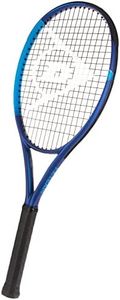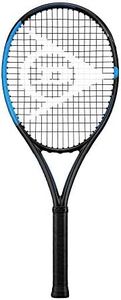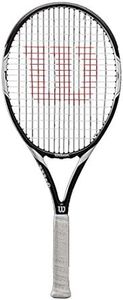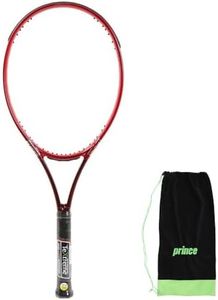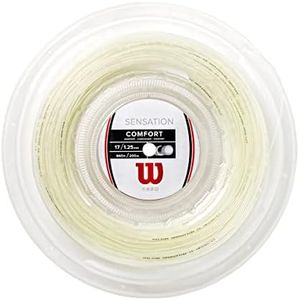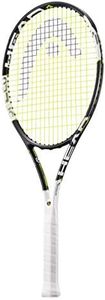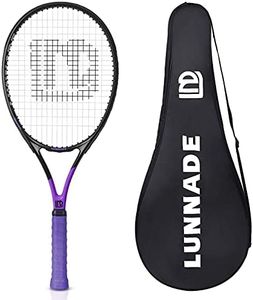We Use CookiesWe use cookies to enhance the security, performance,
functionality and for analytical and promotional activities. By continuing to browse this site you
are agreeing to our privacy policy
10 Best Intermediate Tennis Racquets
From leading brands and best sellers available on the web.Buying Guide for the Best Intermediate Tennis Racquets
Choosing the right intermediate tennis racquet is essential for improving your game, ensuring comfort, and preventing injuries. At this level, your strokes are developing more consistency and you’re likely starting to identify your personal style of play. The racquet you pick should help bridge the gap between a beginner-friendly frame and more advanced, specialized options. Focus on a racquet that offers a good mix of control, power, and maneuverability, and test out different racquets to see which one feels best in your hand. Pay attention to the specifications that influence how the racquet handles, as these will play a big role in your performance and overall enjoyment.WeightWeight refers to how heavy the racquet is when strung and ready to play. This spec is important because the racquet’s weight affects how easily you can swing it, how much power you generate, and how much shock is absorbed. Lighter racquets (around 265-285 grams) are easy to maneuver and suit players who rely on speed and quick reactions, but can lack stability. Midweight racquets (around 285-305 grams) strike a balance between power and control, making them well-suited for most intermediate players. Heavier racquets (above 305 grams) offer more stability and can generate more powerful shots, but may tire out your arm faster and require better technique. For most intermediate players, a midweight racquet helps with both developing control and adding a bit more power, while still being comfortable during longer sessions.
Head SizeHead size is the area of the racquet’s hitting surface, measured in square inches or centimeters. This matters because it determines the size of the sweet spot (the best place to hit the ball) and how forgiving the racquet is on off-center shots. Small head sizes (below 98 sq in) offer maximum control but require precise hitting, while midsize heads (98-104 sq in) provide a good mix of power and control, ideal for intermediates. Larger heads (above 104 sq in) give the biggest sweet spot and help generate more power, but may sacrifice some control. If you’re still working on consistently hitting the ball in the center, a slightly larger head (100-104 sq in) will make your experience more enjoyable and help you build confidence.
BalanceBalance refers to where the weight is distributed throughout the racquet—either more towards the head (head-heavy), the handle (head-light), or evenly distributed (even balance). This affects maneuverability and power. Head-heavy racquets help generate power and are good for baseline rallies, but can feel sluggish at the net. Head-light racquets are easier to control and maneuver, making them great for volleying and quick exchanges. Even balance racquets strive for the best of both worlds. Intermediate players usually benefit from either an even or slight head-light balance, as it supports versatility and helps with developing technique in both baseline and net play.
String PatternString pattern describes how the racquet’s strings are laid out, commonly noted as open (like 16x19) or dense (like 18x20). An open pattern gives you more spin and a softer feel, making it easier to add topspin or slice but sometimes at the cost of durability. A dense pattern gives more control and a longer-lasting string bed but less spin. For intermediates, an open or semi-open pattern is helpful—it rewards growing skills with easier access to spin while offering enough control for improving shot accuracy.
LengthLength is how long the racquet is from the tip of the head to the bottom of the handle, usually measuring 27 inches (the standard) or slightly longer. Longer racquets (up to 27.5 inches) provide more leverage, making serves and groundstrokes more powerful, but are a bit harder to control. Standard length racquets offer a familiar, well-balanced feel. For most intermediate players, the standard length gives solid stability and maneuverability, making it easier to develop all-around skills.
Grip SizeGrip size is how thick the handle is, and it’s important for comfort and injury prevention. Too small a grip can force you to grip too tightly and lead to tennis elbow, while too large a grip can limit your wrist movement, affecting control and comfort. Grip sizes are usually numbered (like 1-5) or measured in millimeters. To choose the right one, try holding the racquet—when you hold it in your playing hand, there should be just enough space to fit the width of your finger between your fingertips and the base of your palm. This fit helps prevent hand strain and keeps your technique consistent.


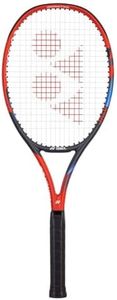
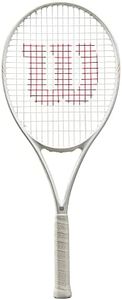
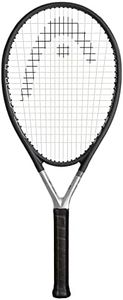
![Prince 7TJ173 Hard Tennis Racquet Tour O3 100 (305) (Tour Aussley 100 (305 g) G2 [Frame Only] White x Gold](https://images-proxy.bestreviews.guide/Udz2yfIc05QXIrrIWf1TVKnQS6s=/0x300/https://m.media-amazon.com/images/I/21DQjtsYxfL._AC_CX679_.jpg)

